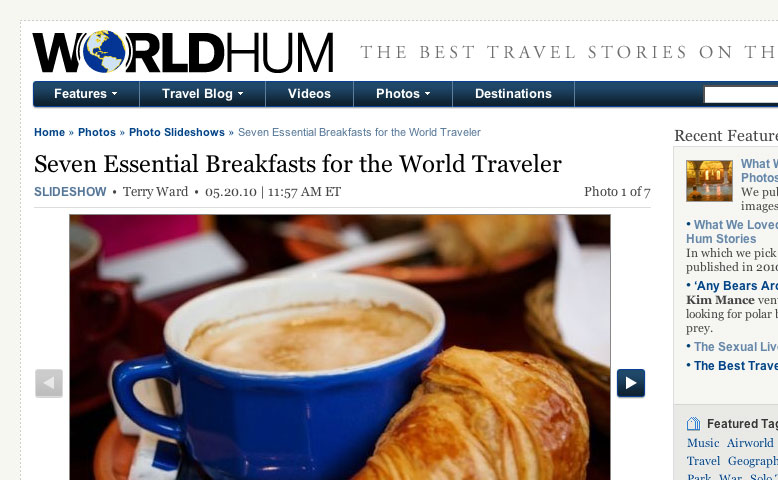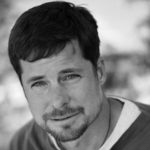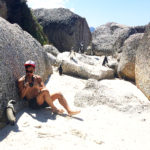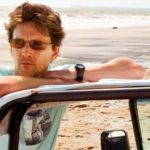Jim Benning and Michael Yessis are the cofounders and coeditors of WorldHum.com, a culture and travel website that celebrates its 10th anniversary this month. Countless travel publications and websites tell you where to go, where to stay, what to do. World Hum focuses not only on destinations but on the journey, on travel in the broadest sense of the word.
Benning has worked for the Travel Channel and various newspapers, and his writing has appeared in magazines and books. Yessis has worked for the Travel Channel, USA Today and other publications.
How did you get started traveling?
JB: My parents loved camping. When I was a kid we camped everywhere from Baja beaches to the Canadian Rockies in a Volkswagen van. I’m sure my wanderlust was born on those trips. In high school I went on surf trips with friends, eventually venturing to some pretty remote point breaks in Mexico. It’s funny, the goal of those trips was always finding killer waves, but in hindsight, the greatest reward wasn’t the surf. It was exploring that foreign world. I loved it, and it left me hungry for more.
MY: My dad worked for Trans World Airlines, so I’ve been a citizen of Airworld since as early as I can remember. As an employee, my dad’s benefits included flight privileges for the entire family. We could fly for free on any flight with space available, and we took advantage of it. After early family trips to New York, London and beyond, I’d locked in my love of travel. By the time I was a teenager, I’d received my own laminated green pass and started to travel around the country on my own. My earliest quest: to visit every Major League Baseball stadium.
How did you get started writing?
JB: I took a journalism class in college and worked on the college paper, but my first paying journalism job was as a reporter at a community newspaper, where I covered crime, city council meetings, local characters.
MY: I fell in love with words early — my dad used to bring home newspapers and magazines from planes, and I delivered the local newspaper, The Daily Breeze. But I never thought of writing as a career until I stumbled into a college journalism class. My professor’s passion was infectious. Within two years I was the editor of the paper. I got my first paying gig while in school, covering high school and college sports part-time for the Santa Monica Outlook, a newspaper published by the company whose papers I delivered as a kid.
What do you consider your first “break” as a writer?
JB: After college I landed a freelance reporting job at the Los Angeles Times. My lucky break was working for a great editor, Rebecca Allen, who scrutinized everything I wrote. I’d watch over her shoulder as she edited my stories. She’d ask hard questions, clarify language, shuffle paragraphs. I still remember her sending a feature story I’d written about surfing back to me for revisions, saying, “I want to feel the sand between my toes.” She pushed me. My ego took a beating, and my writing improved every day.
MY: The sportswriting position at the Outlook, which was made possible by my journalism professor, Jolene Combs. She believed in me enough to get me an interview at the paper. I got the job, in large part because she’d taught me well.
As a traveler and fact/story gatherer, what is your biggest challenge on the road?
JB: I never really wanted to write a lot of stories about lazing around swimming pools or sipping margaritas, which is what I might do if my goal is to relax. So I think the biggest challenge is often a psychological one: just pushing myself into the kinds of situations and experiences that will make for a good story. That means talking to strangers and seeking out places I might otherwise avoid. Fortunately, the rewards almost always outweigh any risks or discomfort.
MY: I, too, have to remind myself to venture into environments and situations that I might find a little uncomfortable or strange.
What is your biggest challenge in the research and writing process?
JB: Finding the story. As a newspaper reporter covering news, I had a very easy time determining the focus of my article. It was the murder, or the controversial election. But travel stories are different animals. You can tell a number of different stories about a travel experience. Which will be most compelling? How best to structure it? Writing an essay that weaves together a travel experience with an exploration of ideas is harder still. Fortunately, the challenge is also part of the fun.
MY: Since I spend the vast majority of my time as an editor, my biggest research and writing challenge is getting out in the world and actually researching and writing stories. When I do write stories, though, I’m with Jim: I want to make sure I find the story. I’ll also add that, from an editor’s perspective, writers who can sniff out not just a good story, but the kind of story that’s appropriate for a given publication, are much appreciated.
What is your biggest challenge from a business standpoint?
JB: When I was working as a full-time freelancer for about 10 years, it was always just paying the bills. It was hard then and I fear it’s only getting harder today. As we prepare to build an independent business around World Hum and to think about other projects, the challenge will be figuring out how to make money beyond online advertising. As we all know, old business models for publishing just don’t work online.
MY: With the exception of a few years freelancing in the late 90s and early 00s, I’ve spent my career working on staff as an editor. So I haven’t had the daily business challenges of many independent writers. I have had to keep in mind the business challenges of the companies I’ve worked for, which has included trying to navigate the Wild, Wild West environment of online publishing. It’s a huge challenge: How can a high-quality editorial site be sustained when the old advertising-driven publishing model doesn’t work?
Have you ever done other work to make ends meet?
JB: I’ve worked as a reporter, freelance writer or editor since college. As a freelancer, I often found myself taking on assignments I wouldn’t have otherwise to pay the bills. I wrote about the jewelry industry, for example. The idea was always to get enough of those jobs to subsidize projects closer to my heart.
MY: During my three years as a part-time sportswriter, I also worked as a clerk in a grocery store. Stocking toilet paper and scanning boxes of cereal paid a lot more than journalism. During my freelance years, I made a few bucks sitting on a focus group and selling a couple things on eBay.
What travel authors or books might you recommend and/or have influenced you?
JB: For books on travel writing, I like The Lonely Planet Guide to Travel Writing by Don George, and Michael Shapiro’s A Sense of Place, which features thoughtful interviews with travel writers. In terms narrative travel books, I love Pico Iyer’s The Lady and the Monk and anything by Paul Theroux. Jack Kerouac’s On the Road and The Dharma Bums left a lasting impression on me. I love the restless spirit of those books.
MY: Felipe Fernandez-Armesto’s Pathfinders: A Global History of Exploration offers a terrific, thorough look at the evolution of travel. I loved Caroline Alexander’s The Bounty and all of Bill Bryson’s books, which turned me on to other travel writers with a humorous streak. Round Ireland with a Fridge by Tony Hawks is a favorite. I, too, hold a special place for On the Road.
What advice and/or warnings would you give someone who is considering going into travel writing?
JB: Travel and read tons. Write a lot. Experiment with different kinds of storytelling, because the digital revolution is creating all kinds of new opportunities for telling travel stories. Finally, don’t bank on making a good living at it. Do it because you love it.
MY: Read and write, read and write, read and write. Repeat. Foremost, create a foundation as a solid writer. With a few bucks, anyone can travel. Not everyone knows how to report or craft a story. Know too that, to make a living, you’re likely going to have to do things other than travel writing or blogging. Alternately, go entrepreneurial and go digital. As I mentioned earlier, it’s the Wild, Wild West out there. Create your own blog, create your own business, be your own brand. People are experimenting with new ways to tell stories and make money online. If you’ve got low overhead, take the digital plunge.
What is the biggest reward of life as a travel writer?
JB: If you’re going someplace with the intention of writing about it, you’re going to push yourself to experience that place more fully than you might otherwise. You’ll observe with a keener eye. You’ll talk to more strangers. You’ll dive deeper. You’ll — you hope — live larger. That’s reward enough, but by doing that over and over again, you get better at it. You cultivate a sense of fearlessness and openness, and with luck, you find yourself applying the same approach to life back home. The greatest reward is learning to experience the world, wherever you are, with greater curiosity and sensitivity, and with a deeper sense of wonder and adventure.
MY: As I mentioned earlier, I spend far more time on the editing side of things, working with writers out and about in the world. During the days when I was spending more time traveling and writing, however, I took great pleasure in the simple act of traveling, moving from one place to the other. I guess I still do, no matter the purpose. It’s just as exciting to me as it was when I started traveling with my family.





